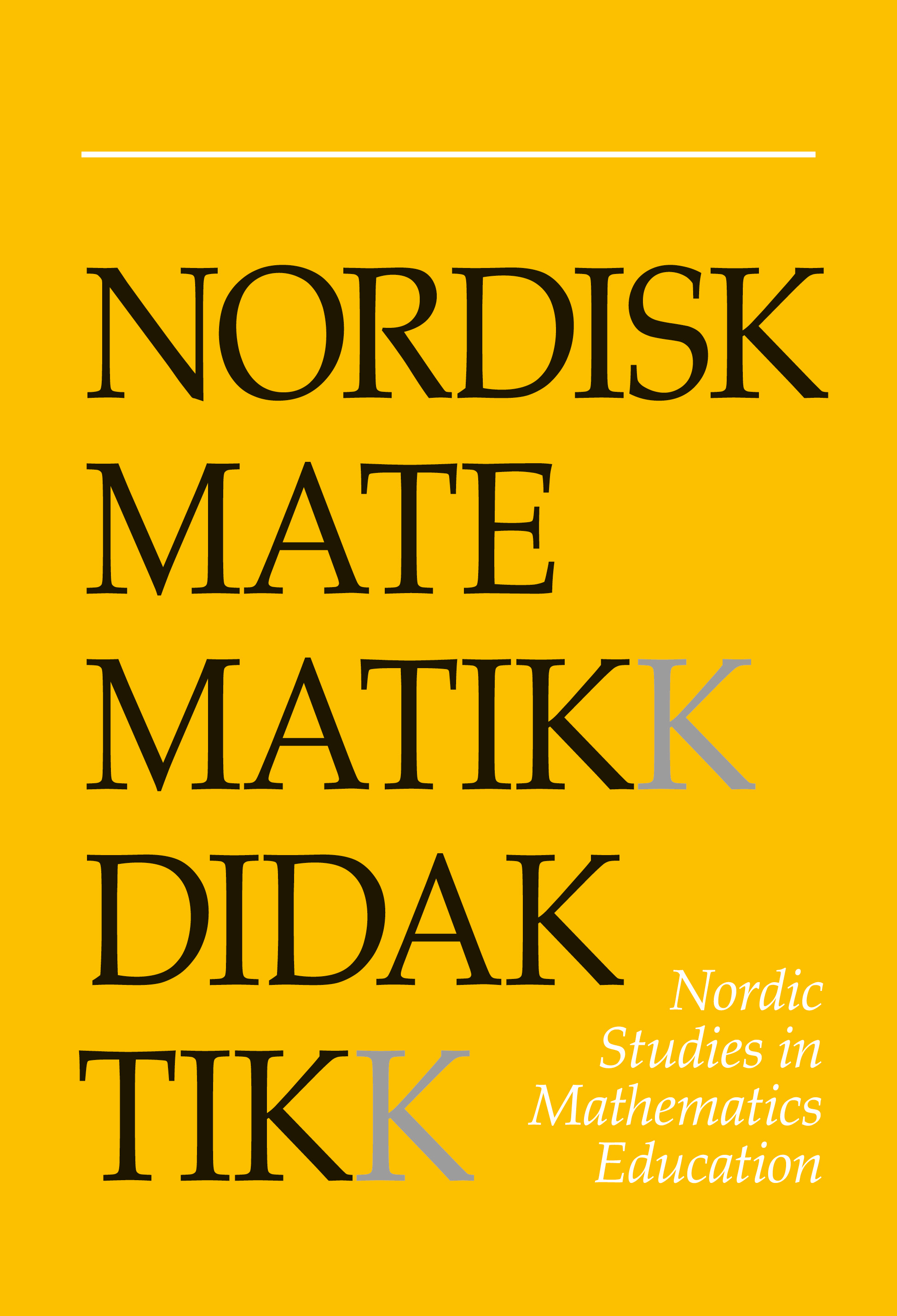Disciplinary competence descriptions for external use
DOI:
https://doi.org/10.7146/nomad.v23i2.148952Abstract
The article addresses the need for competence descriptions of disciplines as a means for fostering more productive communication between different disciplines and between the disciplines and their surroundings. It is argued that the usual competence descriptions devised for use within a discipline itself, e.g. in relation to teaching and learning of the discipline – so-called competence descriptions for internal use – are not the best means to achieve this. The same is true for the general, non-disciplinary competence descriptions. Instead, specially devised disciplinary competence descriptions for external use are called for. Our main illustration is a com- petence description of mathematics for external use devised so that it can support the dialogue about justification of mathematics education between the discipline’s practitioners and its recipients. This description for external use is counterposed with one for internal use i.e. that of the Danish KOM project. It is also counterposed with a competence description for external use for physics, taking into account the different justification problem of physics education. Together these two descriptions showcase how competence descriptions of disciplines for external use may support interdisciplinary collaboration and division of labor in the educational system.
References
Blomhøj, M. (2001). Hvorfor matematikundervisning - matematik og almendannelse i et højteknologisk samfund. In M. Niss (Ed.), Matematikken og verden (pp. 218-246). København: Forfatterne og Forlaget A/S.
Davis, P. J. & Hersh, R. (1981). The mathematical experience. London: Pinguin Books.
Hamming, R. W. (1980). The unreasonable effectiveness of mathematics. The American Mathematical Monthly, 87 (2), 81-90. https://doi.org/10.1080/00029890.1980.11994966
Han, S. H. (2010). Competence, employability, and new social relations of work and learning. In S. H. Han (Ed.), Managing and developing core competences in a learning society (pp. 1-24). Seoul National University Press.
Ikeda, T. & Stephens, M. (1998). The influence of problem format on students' approaches to mathematical modeling. In P. Galbraith, W. Blum, G. Booker & I. Huntley (Eds.), Mathematical modeling: teaching and assessing in a technology-rich world (pp. 223-232). Chichester: Ellis Horwood.
Jankvist, U. T. & Misfeldt, M. (2015). CAS-induced difficulties in learning mathematics? For the Learning of Mathematics, 35 (1), 15-20.
Jankvist, U. T. & Toldbod, B. (2005). Matematikken bag Mars-missionen - transskriberede interviews fra DTU, Brown University, MIT og JPL. IMFUFA tekst no. 449c. Roskilde University.
Jensen, J. H. (1991). Why interdisciplinarity? In A. Lorentsen & A. Kolmos (Eds.), Quality by theory and practice of higher education (pp. 93-96). Aalborg University.
Jensen, J. H. (2012). På tværs af videnskaberne. In T. Enevoldsen & E. Jelsøe (Eds.), Tværvidenskab i teori og praksis (pp. 50-70). København: Hans Reitzels Forlag.
Jensen, J. H. & Jankvist, U. T. (2018). Disciplines and ways of perception: linking interdisciplinarity and competences. In T. Sibbald (Ed.), Teaching interdisciplinary mathematics (pp. 119-132). Champaign: Common Ground Publishing.
Jensen, J. H., Niss, M. & Jankvist, U. T. (2017). Problem solving in the borderland between mathematics and physics. International Journal of Mathematics Education in Science and Technology, 48 (1), 1-15. https://doi.org/10.1080/0020739X.2016.1206979
Jørgensen, B. C. (1998). Mathematics and physics education in society - the justification and enrolment problems from a general perspective. In J. H. Jensen, M. Niss & T. Wedege (Eds.), Justification and enrolment problems in education involving mathematics or physics (pp. 15-32). Roskilde University Press.
Lewis, J. L. (Ed.). (1972). Teaching school physics. A Unesco source book. Harmondsworth: Penguin Books.
Niss, M. (1994). Mathematics in society. In R. Biehler, R. W. Scholz, R. Sträßer & B. Winkelmann (Eds.), Didactics of mathematics as a scientific discipline (pp. 367-378). Dordrecht: Kluwer Academic Publishers.
Niss, M. (2000). Forecasting populations. The UMAP Journal, 21 (1), 73-96.
Niss, M. (2010). Modeling a crucial aspect of students' mathematical modeling. In R. Lesh, P. L. Galbraith, C. R. Haines & A. Hurford (Eds.), Modeling students' mathematical modeling competencies: ICTMA 13 (pp. 43-59). New York: Springer. https://doi.org/10.1007/978-1-4419-0561-1_4
Niss, M. & Jensen, T. H. (Eds.). (2002). Kompetencer og matematiklæring - ideer og inspiration til udvikling af matematikundervisning i Danmark (Uddannelsesstyrelsens temahæfteserie, no. 18). København: Undervisningsministeriet.
Niss, M. & Højgaard, T. (Eds.). (2011). Competencies and mathematical learning - ideas and inspiration for the development of mathematics teaching and learning in Denmark (English edition. IMFUFA tekst no. 485). Roskilde University.
OECD. (2001). Knowledge and skills for life - first results from PISA 2000. Paris: OECD.
OECD. (2013). PISA 2012 Assessment and analytical framework: mathematics, reading, science, problem solving and financial literacy. Paris: OECD Publishing.
Smithers, A. & Robinson, P. (2006). Physics in schools and universities II: patterns and policies. Carmichael Press, University of Buckingham.
Stillman, G. & Brown, J. P. (2014). Evidence of implemented anticipation in mathematising by beginning modelers. Mathematics Education Research Journal, 26, 763-789. https://doi.org/10.1007/s13394-014-0119-6
UVM. (2006). Uddannelse - udvalgte nøgletal. København: Undervisnings- ministeriet. Retrieved from http://static.uvm.dk/Publikationer/2006/ uddannelsestal/UVM_soroe.pdf
Wigner, E. (1960). The unreasonable effectiveness of mathematics in the natural sciences. Communications in Pure and Applied Mathematics, 13 (1), 1-14. https://doi.org/10.1002/cpa.3160130102
Downloads
Published
How to Cite
Issue
Section
License

This work is licensed under a Creative Commons Attribution-NonCommercial-ShareAlike 4.0 International License.



